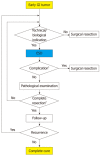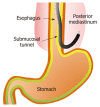Endoscopic submucosal dissection and surgical treatment for gastrointestinal cancer
- PMID: 23189214
- PMCID: PMC3506953
- DOI: 10.4253/wjge.v4.i10.438
Endoscopic submucosal dissection and surgical treatment for gastrointestinal cancer
Abstract
Endoscopic submucosal dissection (ESD) is widely used in Japan as a minimally invasive treatment for early gastric cancer. The application of ESD has expanded to the esophagus and colorectum. The indication criteria for endoscopic resection (ER) are established for each organ in Japan. Additional treatment, including surgery with lymph node dissection, is recommended when pathological examinations of resected specimens do not meet the criteria. Repeat ER for locally recurrent gastrointestinal tumors may be difficult because of submucosal fibrosis, and surgical resection is required in these cases. However, ESD enables complete resection in 82%-100% of locally recurrent tumors. Transanal endoscopic microsurgery (TEM) is a well-developed surgical procedure for the local excision of rectal tumors. ESD may be superior to TEM alone for superficial rectal tumors. Perforation is a major complication of ESD, and it is traditionally treated using salvage laparotomy. However, immediate endoscopic closure followed by adequate intensive treatment may avoid the need for surgical treatment for perforations that occur during ESD. A second primary tumor in the remnant stomach after gastrectomy or a tumor in the reconstructed organ after esophageal resection has traditionally required surgical treatment because of the technical difficulty of ER. However, ESD enables complete resection in 74%-92% of these lesions. Trials of a combination of ESD and laparoscopic surgery for the resection of gastric submucosal tumors or the performance of sentinel lymph node biopsy after ESD have been reported, but the latter procedure requires a careful evaluation of its clinical feasibility.
Keywords: Colorectal cancer; Complications; Endoscopic submucosal dissection; Esophageal cancer; Gastrectomy; Gastric cancer; Laparoscopic surgery; Lymph node metastasis; Perforation.
Figures






Similar articles
-
AGA Institute Clinical Practice Update: Endoscopic Submucosal Dissection in the United States.Clin Gastroenterol Hepatol. 2019 Jan;17(1):16-25.e1. doi: 10.1016/j.cgh.2018.07.041. Epub 2018 Aug 2. Clin Gastroenterol Hepatol. 2019. PMID: 30077787 Review.
-
Laparoscopic lymph node dissection after endoscopic submucosal dissection: a novel and minimally invasive approach to treating early-stage gastric cancer.Am J Surg. 2005 Sep;190(3):496-503. doi: 10.1016/j.amjsurg.2005.05.042. Am J Surg. 2005. PMID: 16105543 Clinical Trial.
-
Endoscopic submucosal dissection for foregut neuroendocrine tumors: an initial study.World J Gastroenterol. 2012 Oct 28;18(40):5799-806. doi: 10.3748/wjg.v18.i40.5799. World J Gastroenterol. 2012. PMID: 23155323 Free PMC article.
-
Colorectal endoscopic submucosal dissection: Technical advantages compared to endoscopic mucosal resection and minimally invasive surgery.Dig Endosc. 2014 Jan;26 Suppl 1:52-61. doi: 10.1111/den.12196. Epub 2013 Nov 5. Dig Endosc. 2014. PMID: 24191896 Review.
-
Clinical outcomes of minimally invasive treatment for early gastric cancer in patients beyond the indications of endoscopic submucosal dissection.Surg Endosc. 2018 Sep;32(9):3798-3805. doi: 10.1007/s00464-018-6105-4. Epub 2018 Feb 20. Surg Endosc. 2018. PMID: 29464402
Cited by
-
Gastric carcinoma: imaging diagnosis, staging and assessment of treatment response.Cancer Imaging. 2013 May 30;13(2):212-27. doi: 10.1102/1470-7330.2013.0023. Cancer Imaging. 2013. PMID: 23722535 Free PMC article. Review.
-
Delayed esophageal perforation occurring with endoscopic submucosal dissection: A report of two cases.World J Gastrointest Surg. 2015 Jul 27;7(7):123-7. doi: 10.4240/wjgs.v7.i7.123. World J Gastrointest Surg. 2015. PMID: 26225195 Free PMC article.
-
Endoscopic submucosal dissection: experience in an Australian tertiary center.Ann Gastroenterol. 2014;27(3):212-218. Ann Gastroenterol. 2014. PMID: 24976337 Free PMC article.
-
Diffuse gastric cancer: histologic, molecular, and genetic basis of disease.Transl Gastroenterol Hepatol. 2020 Oct 5;5:52. doi: 10.21037/tgh.2020.01.02. eCollection 2020. Transl Gastroenterol Hepatol. 2020. PMID: 33073047 Free PMC article. Review.
-
Repeat endoscopic submucosal dissection for recurrent gastric cancers after endoscopic submucosal dissection.World J Gastrointest Endosc. 2013 Dec 16;5(12):600-4. doi: 10.4253/wjge.v5.i12.600. World J Gastrointest Endosc. 2013. PMID: 24368936 Free PMC article.
References
-
- Hirao M, Masuda K, Asanuma T, Naka H, Noda K, Matsuura K, Yamaguchi O, Ueda N. Endoscopic resection of early gastric cancer and other tumors with local injection of hypertonic saline-epinephrine. Gastrointest Endosc. 1988;34:264–269. - PubMed
-
- Gotoda T, Sasako M, Ono H, Katai H, Sano T, Shimoda T. Evaluation of the necessity for gastrectomy with lymph node dissection for patients with submucosal invasive gastric cancer. Br J Surg. 2001;88:444–449. - PubMed
-
- Tajima Y, Nakanishi Y, Ochiai A, Tachimori Y, Kato H, Watanabe H, Yamaguchi H, Yoshimura K, Kusano M, Shimoda T. Histopathologic findings predicting lymph node metastasis and prognosis of patients with superficial esophageal carcinoma: analysis of 240 surgically resected tumors. Cancer. 2000;88:1285–1293. - PubMed
-
- Gotoda T, Yanagisawa A, Sasako M, Ono H, Nakanishi Y, Shimoda T, Kato Y. Incidence of lymph node metastasis from early gastric cancer: estimation with a large number of cases at two large centers. Gastric Cancer. 2000;3:219–225. - PubMed
-
- Kitajima K, Fujimori T, Fujii S, Takeda J, Ohkura Y, Kawamata H, Kumamoto T, Ishiguro S, Kato Y, Shimoda T, et al. Correlations between lymph node metastasis and depth of submucosal invasion in submucosal invasive colorectal carcinoma: a Japanese collaborative study. J Gastroenterol. 2004;39:534–543. - PubMed
LinkOut - more resources
Full Text Sources
Miscellaneous

